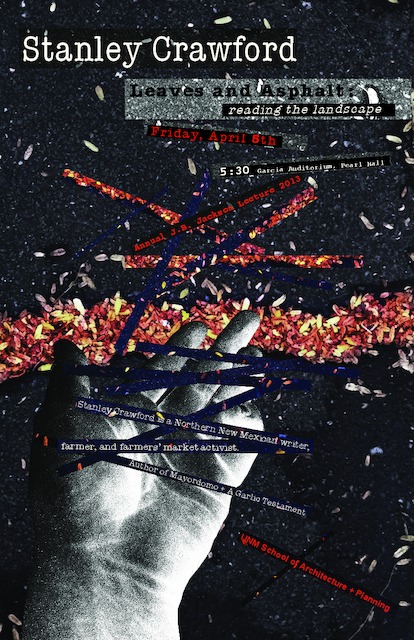Stanley Crawford, novelist, memoirist and garlic farmer is telling me about the experience of driving back to his home near Dixon after a day of shopping, movie-going and dinner in Santa Fe. He talks of leaving the barrage of consumer goods and emerging into the Rio Grande canyon; the feeling of being suddenly surrounded by rocks and juniper and piñon. “When you’re in the city, the city is telling you what to do, every step: go here, don’t go here, buy this, don’t buy that, whatever … then, suddenly, we’re in a landscape of rocks and trees and they’re not telling us anything. They’re saying only, possibly, that our lives here are very ephemeral … and maybe to cut our egos down to a slighty smaller size.” Then Crawford laughs.Stan Crawford seems like a particularly inspired choice to deliver this year’s J.B. Jackson lecture at the University of New Mexico’s School of Architecture and Planning, a school that we tend to think of as devoted to sheerly urban concerns. In one sense, Crawford seems far, far away from our lives of pavement, desk jobs and exhaust-clogged air. There he is, after all, on his garlic farm by the Embudo River, amidst apple trees, squash and shimmering acequias, basking in sun and dirt, sorting shallots and purple-streaked bulbs for market.In another sense he’s not as far-removed as we’d imagine. As he says in his book, A Garlic Testament: Seasons on a Small New Mexico Farm, “I live on the edge of what so many inhabit the center of … yet … growing garlic doesn’t free me of the need to shop in supermarkets, or negotiate with insurance companies or the government or school systems or hospitals or weapons makers … or much of anything else … ”Indeed, Crawford has been going gangbusters on the edge: penning multiple novels and memoirs; running El Bosque Garlic Farm with his wife Rose Mary; serving as the local acequia mayordomo, and as a member of the Santa Fe Farmers’ Market board. Crawford’s beautiful meditations in A Garlic Testament—on everything from hoeing to harvesting, to cheatgrass and magpies—are evidence that his “edge” is truly a different space, a borderland between the built world and the natural world, bearing characteristics of each—a border that has shriveled over the last century with the fading of the family farm.When I talked to Crawford, he inverted the analogy, referring to the farm as not an “edge” but as the real center of our universe with “tendrils,” such as the socially-activated acequia system and the farmers’ market, that reach out into the community.“It’s not as if you’re farming in isolation,” says Crawford. “You’re connected in all kinds of ways. In a deep, cultural way you’re connected to the ancient past because the crops that we grow were domesticated thousands or tens of thousands of years ago, by processes that we still don’t understand.” Sometimes we need to be reminded, with a poetic and powerful voice, that in terms of geological time, we are, as Crawford says, mere “flecks of sand.”
Leaves and Asphalt: Reading the Landscape
Friday, April 5th, 5:30 p.m.
A talk on sustainability in the farm and the city.
Garcia Auditorium, George Pearl Hall on UNM Main Campus
FREE









